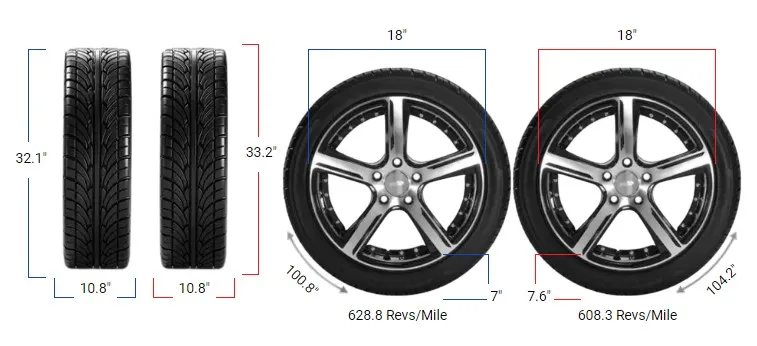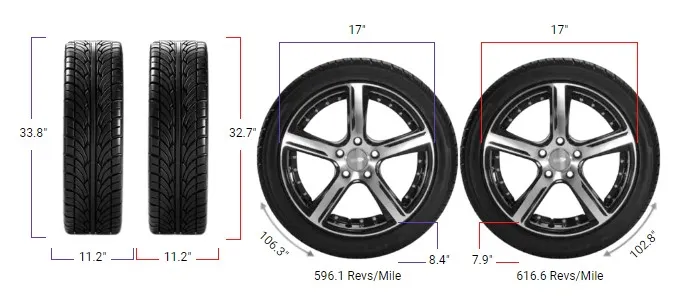Tire Size 195/75r14 vs 195/70r14

Thinking about changing your car’s tires? Switching from 195/75r14 to 195/70r14 might seem small, but it can make a big difference in how your vehicle performs.
- The car will sit slightly lower due to the smaller tire size, reducing ground clearance.
- Handling may improve because the shorter sidewalls offer better steering response.
- Ride comfort could decrease as the tires absorb less shock from bumps and potholes.
- The speedometer might read higher than your actual speed, affecting speed accuracy.
- Fuel efficiency may slightly improve since smaller tires require less energy to rotate.
- Off-road capability could be reduced due to less ground clearance and sidewall flexibility.

Fitment Guide
According to tire fitment guidelines, replacement tires should be within 3% of the original tire’s diameter.
Since the diameter difference between these two sizes is exactly 3%, this switch is at the limit of what’s recommended. Exceeding this range is not advised due to potential issues like rubbing or clearance problems.
On-Road Impact
Switching tires can change how your car behaves on regular roads. Even small differences in size can affect several aspects of your driving experience. Let’s explore how this size change impacts comfort, speed, and efficiency when you’re behind the wheel.

- Ground Clearance: With the smaller diameter of the 195/70r14 tires, your car’s ground clearance decreases by about 0.38 inches. This means the car sits closer to the ground, which can be beneficial for handling but might cause issues with speed bumps or steep driveways. You may need to be more cautious to avoid scraping the underside of your car.
- Gas Mileage: A smaller tire can improve fuel efficiency slightly because it requires less energy to rotate. The engine doesn’t have to work as hard to turn the wheels, which could save you a bit of gas over time. However, the difference is minimal—probably not enough to notice a significant change at the pump.
- Aesthetic Look: The smaller tires might change the appearance of your car. The wheel wells could appear larger, and the vehicle might look lower to the ground. Some people prefer this sportier look, while others might not like the visual gap between the tire and the wheel well.
- Ride Comfort: The sidewall height decreases with the 195/70r14 tires, leading to a firmer ride. The shorter sidewalls absorb less shock from bumps and potholes, so you might feel more of the road’s imperfections. If you prefer a smooth, cushioned ride, this could be a drawback.
- Speedometer Accuracy: A smaller tire rotates more times to cover the same distance. This means your speedometer, which is calibrated for the original tire size, will read higher than your actual speed. The difference is around 3%, so when your speedometer shows 60 mph, you’re actually traveling about 58 mph. This could also affect your odometer readings over time.
- Durability & Wear: Smaller tires may wear out slightly faster due to the increased number of revolutions per mile. More rotations mean more friction and heat, which can lead to quicker tire wear. However, the impact is minor and generally not a major concern for most drivers.
- Handling: The reduced sidewall height can improve handling and steering response. The car may feel more responsive when turning, providing a sportier driving experience. This can be a benefit for those who enjoy a more connected feel to the road.
- Braking Distance: The smaller diameter could slightly reduce braking distance because the tires have less rotational inertia. However, the difference is minimal and might not be noticeable in everyday driving.
- Noise Levels: Tires with shorter sidewalls can sometimes produce more road noise because they absorb less sound. You might notice a slight increase in noise inside the cabin.
Off-Road Impact
If you enjoy off-road adventures, tire size plays a crucial role in your vehicle’s capability. Let’s examine how switching to a smaller tire affects off-road performance.

- Ground Clearance: Reduced ground clearance is more significant off-road. Obstacles like rocks, logs, and uneven terrain require ample clearance to navigate safely. A decrease of nearly half an inch might make certain trails more challenging or even inaccessible.
- Traction: Smaller tires have a reduced contact patch with the ground, which can affect grip on loose or slippery surfaces like mud, sand, or gravel. Less traction can lead to wheel spin and reduced control, especially in challenging off-road conditions.
- Sidewall Flex: Off-roading often requires tires with flexible sidewalls to absorb shocks from rough terrain. The shorter sidewalls of the 195/70r14 provide less flex, which can result in a harsher ride and increased risk of tire damage when navigating obstacles.
- Tire Pressure Adjustments: Off-road drivers sometimes lower tire pressure to increase the contact area and improve traction. With smaller sidewalls, there’s less room to safely reduce pressure without risking tire damage or coming off the rim.
- Approach and Departure Angles: A lower vehicle height can affect your car’s ability to climb over obstacles without scraping the front or rear bumpers. This can limit the types of terrain you can tackle.
195/75R14 vs 195/70R14
| Feature | 195/75R14 | 195/70R14 | Difference |
|---|---|---|---|
| Diameter inches (mm) | 25.52 (648.1) | 24.75 (628.6) | -0.77 (-19.5) -3% |
| Width inches (mm) | 7.68 (195) | 7.68 (195) | 0 (0) 0% |
| Circumference inches (mm) | 80.16 (2036.07) | 77.75 (1974.81) | -2.41 (-61.26) -3% |
| Sidewall Height inches (mm) | 5.76 (146.25) | 5.37 (136.5) | -0.38 (-9.75) -6.7% |
| Revolutions per mile (km) | 790.42 (491.14) | 814.94 (506.38) | 24.52 (15.24) +3.1% |
| Speedo Reading | 20 mph (32.19 km/h) | 19.4 mph (31.22 km/h) | -0.60 mph (-0.97 km/h) |
What is the Main Difference Between 195/75r14 and 195/70r14?
The main difference is that the 195/75r14 tire is slightly larger in diameter than the 195/70r14, affecting the vehicle’s height and performance characteristics.
Can I Use 195/70r14 Instead of 195/75r14?
Yes, you can use 195/70r14 tires instead of 195/75r14, but they are slightly smaller, which may impact speedometer accuracy and ground clearance.
How Much Taller Is a 195/75r14 Tire Than a 195/70r14?
A 195/75r14 tire is slightly taller than a 195/70r14 tire, providing a bit more ground clearance and a higher ride height for the vehicle.
Our Observation
Switching from 195/75r14 to 195/70r14 tires has both benefits and drawbacks. On the plus side, you might experience slightly better fuel efficiency and a sportier feel due to the lower profile of the tires.
The handling could be more responsive on paved roads, which many drivers appreciate. However, the decreased diameter affects ground clearance, which can be a concern both on and off the road.
Off-road enthusiasts might find the reduced ground clearance and sidewall flex to be disadvantages when tackling rough terrain. The speedometer reading will also be slightly off, showing a higher speed than you’re actually going.
Overall, the differences are minor but worth considering based on your driving needs. For everyday on-road driving, the impact is negligible and might even enhance your experience. Off-road drivers might want to stick with the original size to maintain optimal performance.



